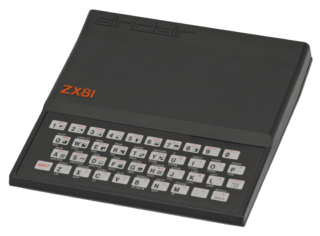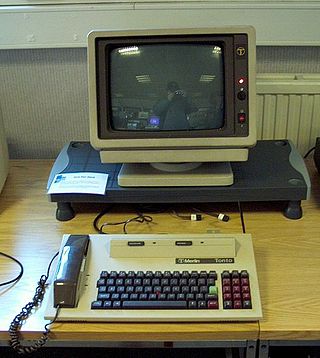
The Commodore 1541 is a floppy disk drive which was made by Commodore International for the Commodore 64 (C64), Commodore's most popular home computer. The best-known floppy disk drive for the C64, the 1541 is a single-sided 170-kilobyte drive for 5¼" disks. The 1541 directly followed the Commodore 1540.

A floppy disk or floppy diskette is a type of disk storage composed of a thin and flexible disk of a magnetic storage medium in a square or nearly square plastic enclosure lined with a fabric that removes dust particles from the spinning disk. The three most popular floppy disks are the 8-inch, 5¼-inch, and 3½-inch floppy disks. Floppy disks store digital data which can be read and written when the disk is inserted into a floppy disk drive (FDD) connected to or inside a computer or other device.

The TRS-80 Micro Computer System is a desktop microcomputer launched in 1977 and sold by Tandy Corporation through their Radio Shack stores. The name is an abbreviation of Tandy Radio Shack, Z80 [microprocessor]. It is one of the earliest mass-produced and mass-marketed retail home computers.
Waveform Audio File Format is an audio file format standard for storing an audio bitstream on personal computers. The format was developed and published for the first time in 1991 by IBM and Microsoft. It is the main format used on Microsoft Windows systems for uncompressed audio. The usual bitstream encoding is the linear pulse-code modulation (LPCM) format.

The ZX81 is a home computer that was produced by Sinclair Research and manufactured in Dundee, Scotland, by Timex Corporation. It was launched in the United Kingdom in March 1981 as the successor to Sinclair's ZX80 and designed to be a low-cost introduction to home computing for the general public. It was hugely successful; more than 1.5 million units were sold. In the United States it was initially sold as the ZX-81 under licence by Timex. Timex later produced its own versions of the ZX81: the Timex Sinclair 1000 and Timex Sinclair 1500. Unauthorized ZX81 clones were produced in several countries.
Turbo Pascal is a software development system that includes a compiler and an integrated development environment (IDE) for the programming language Pascal running on the operating systems CP/M, CP/M-86, and MS-DOS. It was originally developed by Anders Hejlsberg at Borland, and was notable for its very fast compiling. Turbo Pascal, and the later but similar Turbo C, made Borland a leader in PC-based development tools.

CP/M, originally standing for Control Program/Monitor and later Control Program for Microcomputers, is a mass-market operating system created in 1974 for Intel 8080/85-based microcomputers by Gary Kildall of Digital Research, Inc. CP/M is a disk operating system and its purpose is to organize files on a magnetic storage medium, and to load and run programs stored on a disk. Initially confined to single-tasking on 8-bit processors and no more than 64 kilobytes of memory, later versions of CP/M added multi-user variations and were migrated to 16-bit processors.

Punched tape or perforated paper tape is a form of data storage device that consists of a long strip of paper through which small holes are punched. It was developed from and was subsequently used alongside punched cards, the difference being that the tape is continuous.

The Amstrad PCW series is a range of personal computers produced by British company Amstrad from 1985 to 1998, and also sold under licence in Europe as the "Joyce" by the German electronics company Schneider in the early years of the series' life. The PCW, short for Personal Computer Word-processor, was targeted at the word processing and home office markets. When it was launched the cost of a PCW system was under 25% of the cost of almost all IBM-compatible PC systems in the UK, and as a result the machine was very popular both in the UK and in Europe, persuading many technophobes to venture into using computers. The series is reported to have sold 8 million units. However the last two models, introduced in the mid-1990s, were commercial failures, being squeezed out of the market by the falling prices, greater capabilities and wider range of software for IBM-compatible PCs.
In computer science, group coded recording or group code recording (GCR) refers to several distinct but related encoding methods for representing data on magnetic media. The first, used in 6250 bpi magnetic tape since 1973, is an error-correcting code combined with a run-length limited (RLL) encoding scheme, belonging into the group of modulation codes. The others are similar encoding methods used in mainframe hard disks or microcomputer floppy disks until the late 1980s. GCR is a modified form of a NRZI code, but necessarily with a higher transition density.

The IBM 5100 Portable Computer is one of the first portable computers, introduced in September 1975, six years before the IBM Personal Computer, and eight before the first successful IBM compatible portable computer, the Compaq Portable. It was the evolution of a prototype called the SCAMP that was developed at the IBM Palo Alto Scientific Center in 1973. Whether considered evolutionary from SCAMP or revolutionary, it still needed to be plugged into an electric socket.

PDF417 is a stacked linear barcode format used in a variety of applications such as transport, identification cards, and inventory management. "PDF" stands for Portable Data File. The "417" signifies that each pattern in the code consists of 4 bars and spaces in a pattern that is 17 units (modules) long. The PDF417 symbology was invented by Dr. Ynjiun P. Wang at Symbol Technologies in 1991. It is defined in ISO 15438.

A type-in program or type-in listing was computer source code printed in a home computer magazine or book. It was meant to be entered via the keyboard by the reader and then saved to cassette tape or floppy disk. The result was a usable game, utility, or application program.

The TRS-80 Model 100 is a notebook-sized portable computer introduced in April 1983.
The Disc Filing System (DFS) is a computer file system developed by Acorn Computers, initially as an add-on to the Eurocard-based Acorn System 2.

The One Per Desk, or OPD, was a British innovative hybrid personal computer and telecommunications terminal based on the hardware of the Sinclair QL. The One Per Desk was built by International Computers Limited (ICL) and launched in the United Kingdom in 1984. It was the result of a collaborative project between ICL, Sinclair Research and British Telecom, begun in 1983, which originally intended to incorporate Sinclair's flat-screen CRT technology.

The Disk II Floppy Disk Subsystem, often rendered as Disk ][, is a 5 +1⁄4-inch floppy disk drive designed by Steve Wozniak at the recommendation of Mike Markkula, and manufactured by Apple Computer It went on sale in June 1978 at a retail price of US$495 for pre-order; it was later sold for $595 including the controller card and cable. The Disk II was designed specifically for use with the 1977 Apple II personal computer to replace the slower cassette tape storage.

A floppy disk is a disk storage medium composed of a thin and flexible magnetic storage medium encased in a rectangular plastic carrier. It is read and written using a floppy disk drive (FDD). Floppy disks were an almost universal data format from the 1970s into the 1990s, used for primary data storage as well as for backup and data transfers between computers.

The floppy disk is a data storage and transfer medium that was ubiquitous from the mid-1970s well into the 2000s. Besides the 3½-inch and 5¼-inch formats used in IBM PC compatible systems, or the 8-inch format that preceded them, many proprietary floppy disk formats were developed, either using a different disk design or special layout and encoding methods for the data held on the disk.













